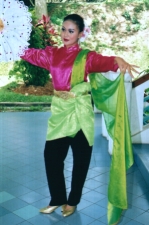As regards the dances of Malaysia, there are many traditional dance forms which are still very much liked and performed in the country. Joget is a conventional dance form which is performed usually by couples, combining fast, graceful movements with good humor. Malaysia's most superb dance form is known to be the Candle Dance in which the candles are fixed on small plates and the dancer performs, holding plates in each hand. It becomes all the more fascinating to the onlooker with elegant body movements and curves.
Many of the dance forms have been originated from martial arts or theatrical forms, like Silat. Silat was actually a deadly martial art accompanied by drums and gongs, but now it has become a full-fledged performing art and is often performed at occasions. In this, the dancers carry out sparring and other graceful movements as per the beats of drums and other musical instruments. For entertaining the royal guests, Malaysians have their own folk dance - Inang.
Many of the dance forms have been originated from martial arts or theatrical forms, like Silat. Silat was actually a deadly martial art accompanied by drums and gongs, but now it has become a full-fledged performing art and is often performed at occasions. In this, the dancers carry out sparring and other graceful movements as per the beats of drums and other musical instruments. For entertaining the royal guests, Malaysians have their own folk dance - Inang.
Inang dance is a modernized version of the traditional mak inang folk dance. It is performed at social functions.
This dance moves at fast tempo set by the rebana, biola and gendang.
The Mak Inang song and dance originated during the period of the Malacca Sultanate. The song is said to have been composed by the order of Sultan Mahmud Shah possibly as a lullaby to help him go to sleep.
The dance is very graceful and has all the qualities of a palace performance. This dance is also called Tarian Si Kembang Cina as it has a strong Chinese flavour in the music. Sometimes the dancers hold long scarves during the performance.
Datun Julud is another popular dance form which is often recognized with Sarawak. This is a longstanding practice of storytelling, while performing dance movements. A dynamic dance form, Lion Dance is a renowned dance from Malaysia which is carried out during Chinese festivals like Chinese New Year. This dance is considered to bring good fortune and improve resistance to evil spirits. It requires perfect co-ordination and elegance on the part of dancers.
 |
| Datun Julud in Sarawak |
 |
| Lion Dance |
In Indian Culture, dance is a form of worship and an expression of the human emotion.
It is difficult to trace the origins of Indian dance but the tradition is extremely old. Initially dance was very much an integral part of the worship and prayer in temples and practiced by devotees who spent their entire lives in the temple – the devadasees.
This has now changed with the times and dance has moved out to the people and the tradition of Indian Dance is very much alive in Malaysia. Among the more popular forms are the Odissi and Bharathanatyam.
 |
| Odissi |

No comments:
Post a Comment